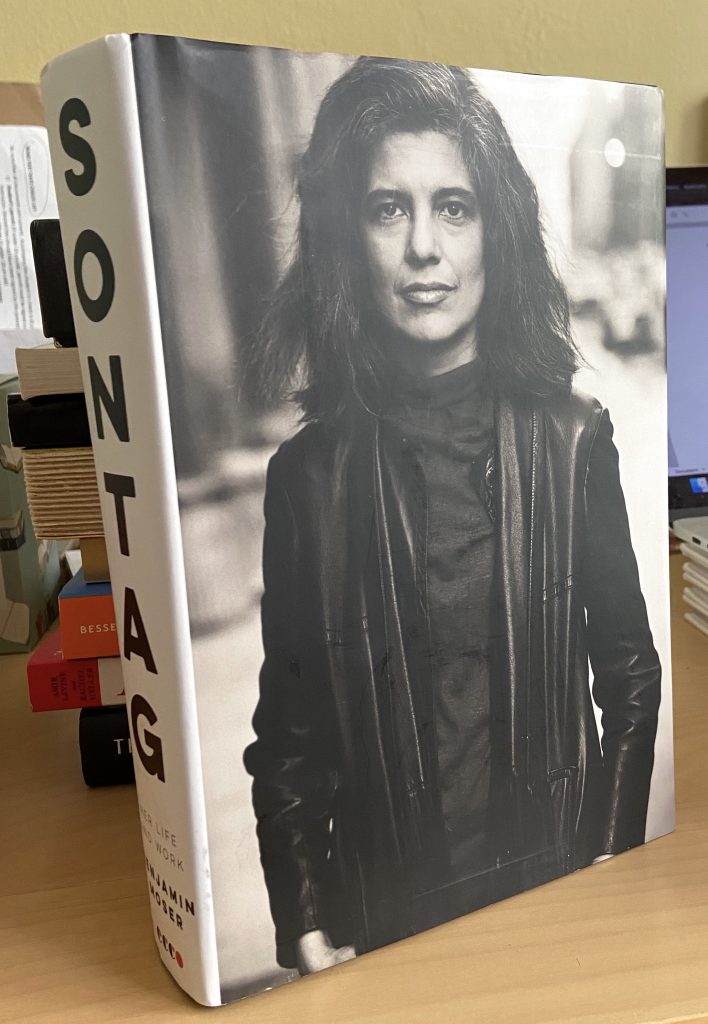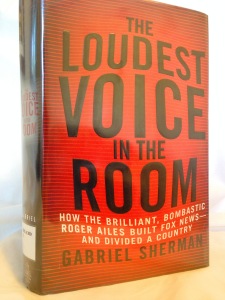Madame de Staël is a biography of my perennial favorite, Germaine de Staël. This one is a much more high-level overview of her life than Mistress to an Age was. It doesn’t talk as much about her philosophy or her writing or her politics, but it does give you a good idea of where she was and who she was with. In fact, where Mistress to an Age sometimes confused me with too much detail, especially when she was traveling through Germany, this book had a lighter touch and was able to give me a much-needed 10,000 foot view. This would have been a good first book on her to have read.
Tag: biography
Just Kids

I feel like Just Kids – a sort of memoir of Patti Smith and a sort of biography of Robert Mapplethorpe – is the prototypical late-1960s, early 1970s artist life in New York City. They have a precarious relationship to getting enough to eat or keeping a roof over their heads, but the art is the focus. When Patti Smith first went to NYC, she very clearly was homeless for awhile, though that phrase is never actually used. And there is much talk about food and hunger.
But mostly, the book is about art. About her helping Robert figure out that he was a photographer, first and foremost. About him helping her with her poetry. (She still writes in poetry on her Instagram account, it’s lovely.) About their struggle to create art and to live on the money they made from their art. In short, to be artists.
And you can see its reflection throughout pop culture, too, the idea that Greenwich Village and Chelsea are places for artists, even though they’re full of wealthy people who have second homes in the suburbs now. But back in the 1960s and early 1970s, they were neighborhoods where artists could afford to live very cheaply and near other artists too.
There is also a thread that follows Robert Mapplethorpe as he discovered that he was gay and how he eventually accepted it – it’s odd for me, now, living in the San Francisco Bay Area to remember how taboo being queer was for so long. And about the eventual photographs that got so much attention from the Republican Party – he was trying to shock and he did.
It ends, after jumping forward several years to cover Mapplethorpe’s death from AIDS in 1989. Another thing it’s hard to remember – and for me to get my teenager to understand – is how pervasive AIDS was and its effect on not only artists, but the US as a whole. (Not everyone survived Reagan.)
I found Just Kids to be inspirational. It’s about Smith finding her voice and forming a band who will be ok with her being the front person. It’s about how fucking around for awhile in your 20s will lead to you figuring out who you are and what you want to do. And as someone who is about to re-figure out what to do with her life, reading about other people doing the same makes me feel less alone.
Debussy: A Painter in Sound

Debussy: A Painter in Sound took me months to read. Far longer than it should have, really. Why? As a high-school trombonist, I’ve played loads of loud, boomy orchestral pieces (think Beethoven, Stravinsky, Mussorgsky) and softer, more delicate, lower-pitched pieces, mostly originally meant for cello (like Bach’s Cello Sonatas). Debussy is most emphatically not that kind of music.
He, like all musicians of his day (late 1800s – v early 1900s), was creating in reaction to 2 main things: Wagner – a bombastic style to be avoided – and Impressionism – a lightness to be embraced. His works are shorter, some only a few bars long, and are largely for instruments like flutes, violins, and pianos. Ergo, the first stumbling block for me was my unfamiliarity with his music.
Debussy is less a biography of the man and more a history of his music. Walsh talks about his rejection of the Conservatory and its standardized notions of what a musician should do, the spareness and lightness of his music, and how it evolves over time. He talks about the spareness of the sound, the arpeggios, the scales, and while I understood the words, I couldn’t hear the music.
Thank god for YouTube, where I could learn about things like octatonic scales, and Spotify, for its numerous recordings of Debussy’s music. Without them, I would have understood so much less. I listen to Debussy regularly now. His music is light and delicate and I’m not sure I would have ever taken the time to listen closely before.
I want, at some point, to learn to play some of his pieces on the piano (and take the years of piano lessons that would render that possible), to listen intensively to all of his music, to go to concerts when we can do that again, and to re-read Debussy with a much more knowledgeable ear and eye.
That’s all you can ask of a book sometimes: to make you want to go down the path it has laid out before you. this one does its job.
Sontag: Her Life and Work

Here’s where I confess that I didn’t know much about Susan Sontag, her life, or her work before reading Sontag: Her Life and Work. I knew of her, of course, I knew she was a Public Intellectual ™, and that as a result many people had strong opinions about her. My own thoughts were a sort of mild disdain that I think comes from being a member of Gen X, and reading criticism of her without engaging with her own actual work beyond Notes on Camp.
I read Michelle Dean’s Sharp a few years ago. That book is a high-level overview of the lives of many 20th century public intellectuals who also happened to be women; Susan Sontag, Hannah Arendt, Dorothy Parker, Nora Ephron, and Joan Didion, amongst others. Without the softening of my views (or maybe a recognition of my own internalized misogyny) by Sharp, I’m not sure I would have decided to read Sontag.
Benjamin Moser has written a very in-depth biography, delving into both her relationships and her intellectual work. She clearly wants to be an intellectual from an early age., and works diligently to make it happen – and I feel like that try-hard-ness is ons of the reasons I was taught to disdain Susan Sontag. Trying wasn’t cool – everything had to be easy or come naturally to be accepted. Susan Sontag was both very smart and didn’t bother to hide her work.
One idea that she engaged with over and over, especially after her initial struggle with breast cancer in her 40s, was the relationship between a thing and its image, how the image, or the metaphor influenced how the reader or viewer thought about the thing itself. Now that we’re all living through the internet because of the pandemic, images and metaphors are what we swim in, even more than normal. I wish she was around and at the top her game right now because I bet she’d have a lot to say about Instagram (and maybe you want to read The Cut essay by Emily Ratajkowski about buying her own images back).
I often end a review with a recommendation, and I often cop out by saying ‘read this if you’re looking for x.” So much of reading and your enjoyment of a thing is dependent on who you are and where you are in your life. Understanding the basics of Susan Sontag’s ideas is essential to understanding how we think of public intellectuals, liberal or conservative, and how our political and media landscapes exist in the world. I would argue that this book will give you a good grounding in understanding those basics, regardless of what exactly you’re looking for.
Finally calling time on a book

I have been reading Alexander Hamilton since 2016 – three years ago. That’s when I added it to Goodreads, anyway. It was more than an idea in Lin-Manuel Miranda’s head, but not the full-on sensation it’s since become.
Hamilton first showed up in Chernow’s biography of George Washington, and Chernow was clearly taken with him. I wanted a follow-up biography about him after I read that one, so I was glad to discover that it had already been written.
So have I finished Alexander Hamilton? Sadly, no. It’s been pushed aside by other books in my to-read pile (I usually have more than one going at a time) and it’s been long enough that I’m finally calling time on it. I may go back to it some day, after all, it’s not like the book is bad. It just got overwhelmed by other things.
I would definitely recommend it if you see the musical and want to know more.
When the patriarchy was even stronger
Agrippina, specifically Agrippina the Younger, was a kind of incredible woman who co-ruled the Roman Empire first with her husband Claudius and then with her son Nero. This book has a distinctly feminist take on her.
Agrippina has often been portrayed as a power-hungry woman who would do anything (e.g. setting up Claudius’ prior wife for political downfall, murdering Claudius so Nero would inherit over Claudius’ natural son, sleeping with Nero once he was on the throne to stay in his good graces) to rule Rome. Mr Barrett’s take on it is as follows:
- Look, she was a powerful woman in a deeply misogynistic society. She’s not going to be portrayed in anything like a positive light.
- She only shows up in the contemporary stories about the men whose lives she was in. We don’t have anything that focuses on her.
- Sex scandals were frequently used by the contemporary sources to explain why powerful people (both men and women) were suddenly not in power anymore.
So when she’s implicated in a sex scandal, it’s important to look around and see who benefits and who else is being taken down with her. That’s going to show you what’s really going on.
Here are the facts: she was raised by an extraordinarily determined mother and her dead father was worshipped by the military. When she was around Caligula (the emperor before Claudius and her brother), he wasn’t such a crazy asshole who tried to kill everyone. Claudius’ reign was much smoother when she was his wife than when he was married to his prior wife. Nero didn’t go off the rails until after she was banished (and then he had her killed to keep her from coming back). Shit worked when she was on the scene.
So maybe consider that the contemporary reports were written by gossipy people with a strong patriarchal bias and should be taken with a HUGE grain of salt.
I liked this one.
People are interesting, companies aren’t
What’s it about?
The Loudest Voice in the Room is about Roger Ailes and Fox News. It’s a biography of a man born into circumstances – hemophilia that turned him into a risk-taker, a mildly abusive father – that combined with his interest in television (and men like the Coors heir who wanted to fund overtly conservative news channels) made Fox News almost a fait accompli. As far as I know, it’s unique in that it’s not written from either a liberal or conservative viewpoint. The book is most interesting when it’s talking about Ailes early life and career. I put it down once it started concentrating on Fox News because I cared way less about that. Ailes is fascinating. Fox News isn’t.
Why should you read it?
I’m not sure you should. It feels like it’s about twice as long as it needs to be; unless you really, really care about the news industry you’ll likely be bored.


